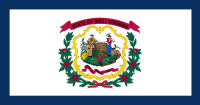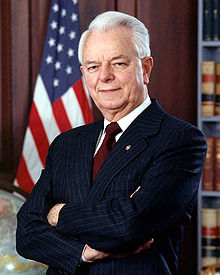Portal:West Virginia
The West Virginia PortalPanorama northwest, northeast and east from a ridge along West Virginia Route 42 between Elk Garden and Sulphur City in Mineral County, West Virginia (2016)
 West Virginia is a landlocked state in the Southern and Mid-Atlantic regions of the United States. It is bordered by Pennsylvania to the north and east, Maryland to the east and northeast, Virginia to the southeast, Kentucky to the southwest, and Ohio to the northwest. West Virginia is the 10th-smallest state by area and ranks as the 12th-least populous state, with a population of 1,793,716 residents. The capital and most populous city is Charleston with a population of 49,055. West Virginia was admitted to the Union on June 20, 1863, and was a key border state during the American Civil War. It was the only state to form by separating from a Confederate state, one of two states (along with Nevada) admitted to the Union during the Civil War, and the second state to separate from another state, after Maine separated from Massachusetts in 1820. Some of its residents held slaves, but most were yeoman farmers, and the delegates provided for the gradual abolition of slavery in the new state constitution. The state legislature abolished slavery in the state, and at the same time ratified the 13th Amendment abolishing slavery nationally on February 3, 1865. West Virginia's northern panhandle extends adjacent to Pennsylvania and Ohio to form a tristate area, with Wheeling, Weirton, and Morgantown just across the border from the Pittsburgh metropolitan area. Huntington in the southwest is close to Ohio and Kentucky, while Martinsburg and Harpers Ferry in the eastern panhandle region are considered part of the Washington metropolitan area, between Maryland and Virginia. West Virginia is often included in several U.S. geographical regions, including the Mid-Atlantic, the Upland South, and the Southeastern United States. It is the only state entirely within the area served by the Appalachian Regional Commission; the area is commonly defined as "Appalachia". (Full article...) Entries here consist of Good and Featured articles, which meet a core set of high editorial standards.
Plantations that operated within the present-day boundaries of West Virginia were located in the counties of the Ridge-and-Valley Appalachians and in the Kanawha and Ohio River valley regions. Beginning in the mid-to-late 18th century, members of the Washington family and other prominent Virginia families began to build elegant Georgian mansions on their plantations in the Ridge-and-Valley Appalachians region of present-day West Virginia. Plantations initially developed in the counties lying within the Northern Neck Proprietary of Thomas Fairfax, 6th Lord Fairfax of Cameron within the Shenandoah Valley and South Branch Potomac River valleys. Slavery as practiced through plantations in the American South was carried over from the plantations of the Piedmont and Tidewater regions of Virginia, where plantations had become the foundation of society and industry. Following the French and Indian War, settlement and agricultural development continued unabated in the Shenandoah and South Branch Potomac valleys. Early instances of western Virginia plantations with grand homes include the John Ariss-designed Harewood (1774) for George Washington's brother Samuel Washington and Happy Retreat (1780) built by Washington's younger brother Charles Washington, both of which are located near Charles Town in present-day Jefferson County. In Hampshire County, Nicholas Casey constructed a Georgian mansion (1774) at his Wappocomo plantation, one of the first plantation houses of its kind in the South Branch Potomac River valley. Plantations continued to develop along the fringes of present-day West Virginia. By the close of the 18th century, Harman Blennerhassett had constructed a mansion on his plantation on Blennerhassett Island and Moses Shepherd had built Shepherd Hall near Wheeling, both in the Ohio River valley. Despite the agricultural development of then western Virginia's bottomlands and the resulting wealth of the plantation owners, the hinterlands of the Allegheny Mountains and Allegheny Plateau regions remained underpopulated and inhabited by subsistence farmers of meager means into the middle of the 19th century. By the 1860 United States Census, Berkeley, Greenbrier, Hampshire, Hardy, Jefferson, Kanawha, and Monroe counties consequently had the largest populations of slaves in present-day West Virginia. (Full article...)Selected article -Robert Carlyle Byrd (born Cornelius Calvin Sale Jr.; November 20, 1917 – June 28, 2010) was an American politician and musician who served as a United States senator from West Virginia for over 51 years, from 1959 until his death in 2010. A Democrat, Byrd also served as a U.S. representative for six years, from 1953 until 1959. He remains the longest-serving U.S. Senator in history; he was the longest-serving member in the history of the United States Congress until surpassed by Representative John Dingell of Michigan. Byrd is the only West Virginian to have served in both chambers of the state legislature and in both chambers of Congress. Byrd's political career spanned more than sixty years. He first entered the political arena by organizing and leading a local chapter of the Ku Klux Klan in the 1940s, an action he later described as "the greatest mistake I ever made." He then served in the West Virginia House of Delegates from 1947 to 1950, and the West Virginia State Senate from 1950 to 1952. Initially elected to the United States House of Representatives in 1952, Byrd served there for six years before being elected to the Senate in 1958. He rose to become one of the Senate's most powerful members, serving as secretary of the Senate Democratic Caucus from 1967 to 1971 and—after defeating his longtime colleague Ted Kennedy for the job—as Senate Majority Whip from 1971 to 1977. Over the next 12 years, Byrd led the Democratic caucus as Senate Majority Leader and Senate Minority Leader. In 1989 he stepped down, following the pressure to make way for new party leadership. As the longest serving Democratic senator, Byrd held the position of President pro tempore four times when his party was in the majority. This placed him third in the line of presidential succession, after the vice president and the Speaker of the House of Representatives. (Full article...)General images -The following are images from various West Virginia-related articles on Wikipedia.
Did you know -
TopicsLargest citiesCategoriesNew articlesThis list was generated from these rules. Questions and feedback are always welcome! The search is being run daily with the most recent ~14 days of results. Note: Some articles may not be relevant to this project.
Rules | Match log | Results page (for watching) | Last updated: 2024-06-03 22:38 (UTC) Note: The list display can now be customized by each user. See List display personalization for details.
Related portalsWikiProjectsAssociated WikimediaThe following Wikimedia Foundation sister projects provide more on this subject:
Sources
|



















































